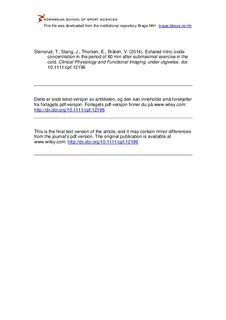| dc.contributor.author | Stensrud, Trine | |
| dc.contributor.author | Stang, Julie | |
| dc.contributor.author | Thorsen, Einar | |
| dc.contributor.author | Bråten, Veslemøy | |
| dc.date.accessioned | 2016-02-18T12:03:29Z | |
| dc.date.available | 2016-02-18T12:03:29Z | |
| dc.date.issued | 2014-10-10 | |
| dc.identifier.citation | Clinical Physiology and Functional Imaging. 2014, under utgivelse. doi:10.1111/cpf.12196 | nb_NO |
| dc.identifier.uri | http://hdl.handle.net/11250/2379514 | |
| dc.description | I Brage finner du siste tekst-versjon av artikkelen, og den kan inneholde ubetydelige forskjeller fra forlagets pdf-versjon. Forlagets pdf-versjon finner du på www.wiley.com: http://dx.doi.org/10.1111/cpf.12196 / In Brage you'll find the final text version of the article, and it may contain insignificant differences from the journal's pdf version. The definitive version is available at www.wiley.com: http://dx.doi.org/10.1111/cpf.12196 | nb_NO |
| dc.description.abstract | Background:
Fractional expired nitric oxide (FENO) is decreased after exercise. The effect of exercise in the cold upon FENO is unknown.
Purpose:
To examine changes in FENO after a short, high intensive exercise test in a cold and in a temperate environment.
Methods:
Twenty healthy well-trained subjects (eight females) aged 18–28 years performed an 8-min exercise test at 18°C (SD = 1.0) and −10°C (SD = 1.2) ambient temperature. The tests were performed in a climate chamber in random order. The workload corresponded to 90–95% of peak heart rate (HRpeak) during the last 4 min. FENO was measured offline. Exhaled gas was sampled in Mylar® bags using a collector kit with a flow restrictor and analysed within 2 h. FENO was measured before exercise and repeatedly during the first hour after. ANOVA for repeated measures was used to compare differences in FENO after exercise between environments.
Results:
There was no difference in baseline FENO. A significant difference in FENO between environments was found after warm-up and from 20 to 30 min after exercise, with FENO being lower after exercise in the cold (P<0.05). The maximal reduction in FENO was seen 5 min after exercise and was not different between environments.
Conclusion:
Recovery of FENO was slower after exercising in −10°C compared with 18°C. | nb_NO |
| dc.language.iso | eng | nb_NO |
| dc.publisher | Blackwell Publishing | nb_NO |
| dc.subject | cold environment | nb_NO |
| dc.subject | exercise | nb_NO |
| dc.subject | exhaled nitric oxide | nb_NO |
| dc.subject | temperate environment | nb_NO |
| dc.title | Exhaled nitric oxide concentration in the period of 60 min after submaximal exercise in the cold | nb_NO |
| dc.type | Journal article | nb_NO |
| dc.type | Peer reviewed | nb_NO |
| dc.subject.nsi | VDP::Mathematics and natural science: 400 | nb_NO |
| dc.subject.nsi | VDP::Mathematics and natural science: 400::Basic biosciences: 470 | nb_NO |
| dc.source.journal | Clinical Physiology and Functional Imaging | nb_NO |
| dc.description.localcode | Seksjon for idrettsmedisinske fag / Department of Sports Medicine | nb_NO |
